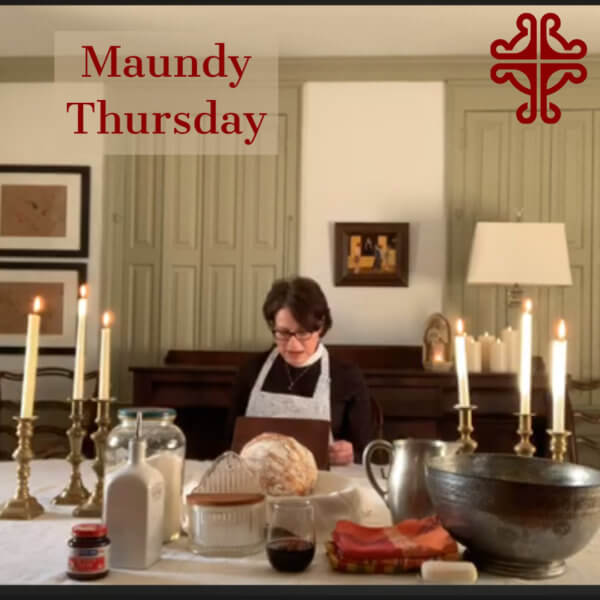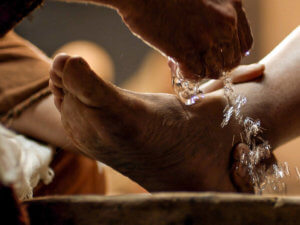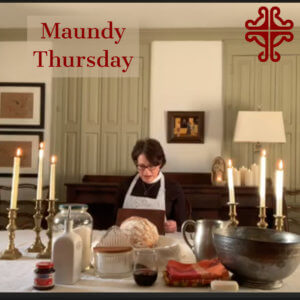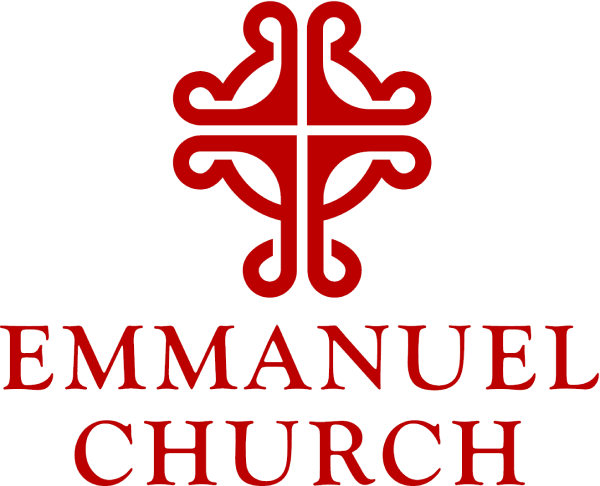

Photo from www.LumoProject.com
Different faith communities have different ways of observing Maundy Thursday — the Thursday of Holy Week. And the Book of Common Prayer special liturgy for Maundy Thursday gives us two choices in the gospel. This is the year for John’s gospel, which is the only one of the four gospels that tells the story of Jesus’ washing the disciples’ feet. John’s gospel is where the custom of foot washing on Maundy Thursday comes from.
Last Supper
The other three gospels — Matthew, Mark, and Luke — give more detail to the Last Supper, where Jesus gives us our familiar words of institution:
He he took the bread, and when he had given thanks he broke it and gave it to them, saying “Take, eat, this is my body.” And he took a cup, and when he had given thanks he gave it to them, saying “Drink of it, all of you, for this is my blood of the covenant, which is poured out for many for the forgiveness of sins.”
It is the Passover meal — or Last Supper — from the gospels of Matthew, Mark, and Luke that is the basis of our Eucharist, or communion.
Mandatum
And it is the “do this in remembrance of me” language from the Last Supper that give us the name of this day — Maundy Thursday — in the church year. Maundy is a shortened form of the Latin word mandatum, which means command. Think of the English word mandate, which is a related word. Many faith communities remember the footwashing from John’s gospel on Maundy Thursday. These communities wash each other’s feet in memory of Jesus’ profound act of humility and service.
And other faith communities emphasize the agape — or friendship — meal that is the basis of our Eucharist, like the Last Supper. And others remember and emphasize the stripping of the altar, after we read the Passion narrative, simplifying our worship space as we wait in vigil for Easter morning and Jesus’ resurrection. I believe that Emmanuel’s tradition emphasizes the footwashing in John’s gospel we that we read tonight. But no matter what our traditions are, I don’t think any of us anticipated that we’d be here — and that our Maundy Thursday liturgy would look like this!
Blessing Where We Are Now
I believe that there is a blessing in where we are now. There is a lot about being in our homes, and away from our beautiful, time-honored sacred spaces. Tonight, we do not need to strip our altar, and put away all of our special liturgical elements, vestments, and furniture to simplify our perspective for our vigil. It’s already bare and spare. But we are together. We are in our homes, where we can already see the holy in the wholly ordinary.
Last year, when I was living in Jerusalem, the holy in the wholly, completely ordinary — frequently caught my attention. It was the very plainest, simplest things that were the most holy. I was often amazed by the pure practicality of these holy spaces, like Holy Sepulchre, for example.
Church of the Holy Sepulchre
 Holy Sepulchre is the Emperor Constantine’s church, built over the Church’s memories of the two holiest sites in the Christian world – Golgotha, where Jesus was crucified, and the first century rock-cut tomb, where the Church remembers Jesus was buried and resurrected. In the year 326 of the common era, Constantine dispatched his mother, Queen Helena, to identify the Christian sites in the Holy Land so that he could build churches over them, resulting in Holy Sepulchre in Jerusalem, and the Church of the Nativity in Bethlehem, the oldest continually used Christian church in the world.
Holy Sepulchre is the Emperor Constantine’s church, built over the Church’s memories of the two holiest sites in the Christian world – Golgotha, where Jesus was crucified, and the first century rock-cut tomb, where the Church remembers Jesus was buried and resurrected. In the year 326 of the common era, Constantine dispatched his mother, Queen Helena, to identify the Christian sites in the Holy Land so that he could build churches over them, resulting in Holy Sepulchre in Jerusalem, and the Church of the Nativity in Bethlehem, the oldest continually used Christian church in the world.
Early in the mornings, the Muslim family that holds the key to Holy Sepulchre for the many Christian orthodox denominations that share the space opens the giant doors with a heavy iron key half the length of my forearm. Right inside the front door are the stone steps up to Golgotha, where Jesus was crucified with the two bandits. Millions of pilgrims climb these steps every year, and after hundreds of years, they are hollowed in the center and very uneven. These steps could be replaced or repaired, but they never are. The wear of the pilgrims’ ordinary, dirty feet are themselves hollowed-out by blessings, the prayers of the ages worn into the rock.
I loved to go inside early in the morning, as the Armenian Orthodox began their daily liturgies in the Edicule — the structure that houses and protects Jesus’ empty tomb. I loved to watch the holy, homey, ordinary things of care and love for what is honored as the holy Christian site in the world.
There was always a nice woman — I never knew her name, because I didn’t have enough Arabic for conversation, but we recognized and nodded at each other. Every morning, she threw down hot, soapy water from a bucket onto those holy stone steps up to Golgotha, and on the altar in front of the rock where the pilgrims kneel to put their hands down into the hole in the rock believed to have held Jesus’ cross. She threw down hot, soapy water and scrubbed those holy steps with a common brush from one of the sellers in the Old City near the Parvis — the courtyard of Holy Sepulchre.
Over in front of the Edicule, the burly altar guild worked, three strong Arab men in t-shirts and jeans, performing the holiest rites of filling and lighting the oil lamps that burn continuously outside Jesus’ empty tomb. They loosen the ropes holding the many lamps from the cleats on the wall that hold them secure, so that they could be lowered and filled. They remove the used and burned wicks were removed with a tiny ladle, and float fresh wicks on the newly poured oil in the lamps. The oil is ordinary Mazola oil — it burns cleaner than olive oil. They buy it in 5-gallon bottles.
Ordinary, Homey, Holy Care
It was a revelation to me to see the loving care that the holy spaces received. It was ordinary, homey, holy care, nothing fancy, and nothing that could only be done with special materials, or only by priests.
Hot water, soap, Mazola oil.
Bread, wine, water.
And that’s the basis of the footwashing ritual too. When Jesus washes his disciples’ feet in John’s gospel, it was because they were dirty. It needed to be done. It was an act of loving service and humility, and he told them — and us — to do that too. Sometimes we can get a little distant from the gospel if we don’t remember the homey things. Like making sure our feet are very clean, or even getting a pedicure first, because we are embarrassed to allow such a practical act of service from someone else. It takes great trust and vulnerability. And that is really what Peter is saying when he objects to Jesus’ washing his feet — no, Lord, it is I who should wash your feet. That’s the proper order of things! But Jesus tells Peter and the disciples — and all of us — that not only will he wash their feet, but that is the humble service we all should offer.
These are strange days. We are not worshiping in our beautiful churches, and some churches have offered their spaces to Christian service. The Cathedral of St. John the Divine in New York will be used as a hospital for Covid patients. Other churches are offering space for food pantries. This is not a “repurposing” or a change in mission — this is core Christian service. It’s faith in action. It’s the very purpose of the worship and liturgies we usually do in the church — to grow our understanding and commitment to the central message of our Christian faith.
Hot water, soap, Mazola oil. Bread, wine, water. It’s the wholly ordinary things that are the most holy and the most needed now. And the beauty of this moment is that we don’t have to strip the altar to see that. I’m going to put these wholly simple, completely holy, things on the altar now — our family table. Amen

Ubi Caritas
https://music.apple.com/us/artist/choir-of-jesus-college-cambridge/359861703
